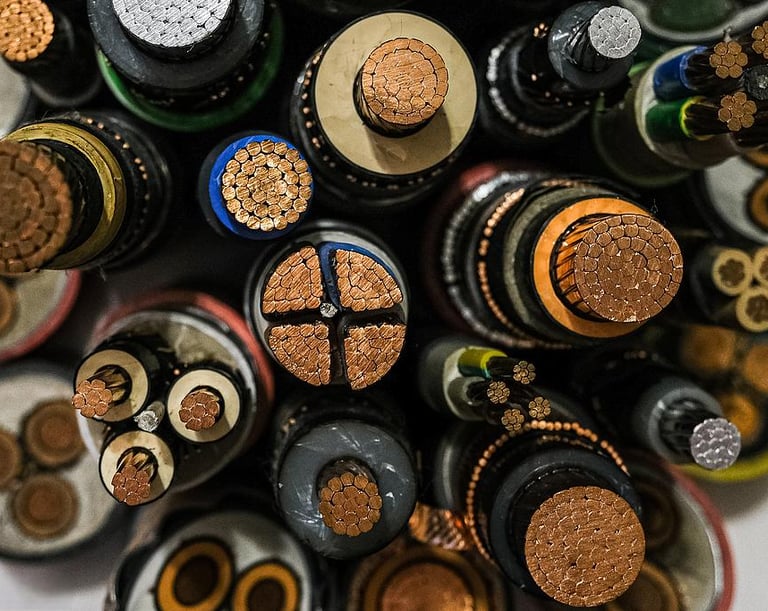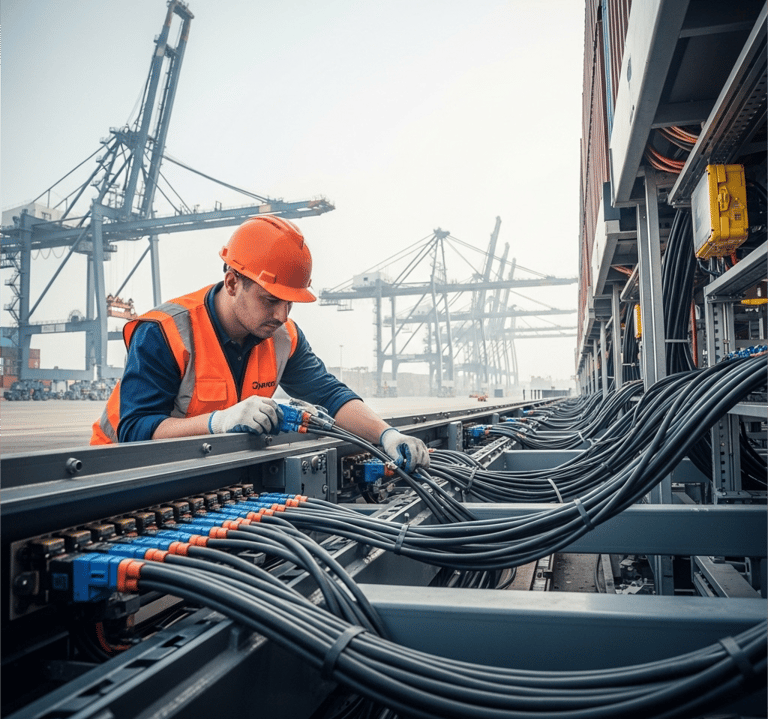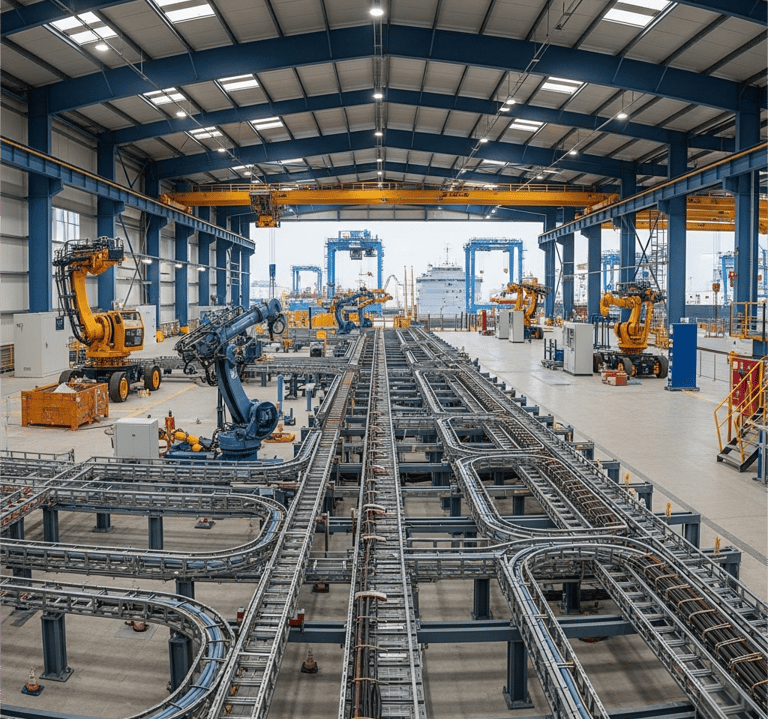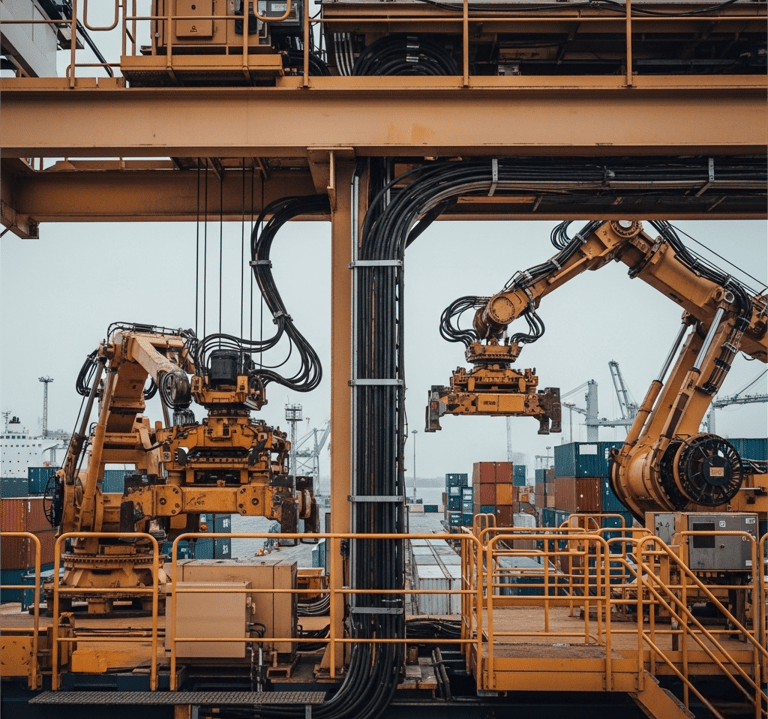📞+86 153 7530 2641 📧 hongjing.Wang@feichuncables.com
Best Practices for Cable Routing in Port Automation Equipment: A Comprehensive Guide
Discover best practices for cable routing in port automation equipment. Learn how to optimise reliability, safety, and efficiency with actionable tips for superior performance in automated port environments.
hongjing.Wang@Feichun
7/15/2025
Introduction
Port automation relies heavily on robust electrical infrastructure, where cable routing serves as the nervous system connecting sophisticated machinery. From container handling equipment to terminal operating systems, proper cable management directly impacts system reliability, operational efficiency, and maintenance requirements. Modern container terminals utilise intricate cable networks powering everything from automated guided vehicles (AGVs) to sophisticated crane control systems.
The complexity of automated port environments demands systematic approaches addressing unique challenges including constant vibration, extreme weather conditions, and rapid maintenance access requirements. When cables fail or experience interference, consequences range from minor operational disruptions to significant safety hazards and costly downtime affecting entire terminal operations.
Drawing from decades of industrial automation experience and established industry standards. The recommendations presented are grounded in real-world port automation scenarios, incorporating insights from leading automation experts and recognised industry bodies, ensuring cable routing systems meet the highest reliability, safety, and performance standards.


Key Considerations for Cable Routing
Environmental Factors
Marine environments present unique challenges with humidity exceeding 80%, constant salt spray exposure, and extreme temperature variations. These conditions accelerate cable degradation and promote corrosion in connection points. Temperature fluctuations can exceed 40°C during single operating cycles, causing cables to expand and contract, potentially creating stress fractures if not properly accommodated through flexible mounting systems.
Salt spray poses particular risks to cable sheaths and metallic components, requiring careful material selection and protective measures. Corrosion can penetrate cable jackets through minor damage, leading to conductor degradation and insulation failure. The marine environment also introduces unique contamination risks from cargo dust, fuel spills, and cleaning chemicals commonly used in port operations.
Wind loading affects cables on tall structures like ship-to-shore cranes, causing oscillation and fatigue failures. Sustained winds create dynamic forces that must be accommodated through appropriate support spacing, flexible connections, and shock-absorbing mounting systems. Proper routing must account for these environmental factors through strategic placement and protective measures.
Equipment Movement and Dynamic Requirements
Automated port equipment involves complex mechanical movements requiring cables that withstand millions of flexing cycles. Robotic container handling systems demand specialised cable management solutions preventing twist and tangling during continuous operation.
Multi-axis equipment presents additional complexity, requiring sophisticated harness designs that prevent cable interference whilst maintaining proper bend radii throughout the entire movement range.
Safety and Compliance
Australian ports must comply with AS/NZS 3000 standards for electrical installations, including specific provisions for hazardous locations. WHS regulations require installations that minimise risks to personnel, providing adequate clearances and clear hazard identification.
Fire safety considerations mandate fire-resistant cable sheaths and appropriate separation distances to prevent propagation whilst ensuring continued operation of critical safety systems.
Cable Selection and Preparation
Cable Types
Polyurethane (PUR) sheathed cables are preferred for port automation due to exceptional resistance to abrasion, chemicals, and UV radiation. They maintain flexibility across wide temperature ranges whilst providing superior mechanical protection. PUR cables demonstrate excellent performance in dynamic applications, withstanding millions of flexing cycles without degradation.
Thermoplastic elastomer (TPE) cables offer excellent flexibility for dynamic applications, with superior low-temperature performance and ozone resistance. TPE compounds maintain elasticity in extreme cold conditions whilst providing resistance to cracking and embrittlement. These cables are particularly suitable for applications involving frequent movement and temperature cycling.
Traditional PVC cables, whilst economical, have limitations in harsh marine environments. Modern PVC formulations with enhanced UV stabilisers and plasticisers can provide adequate performance in less demanding applications. However, PVC becomes brittle at low temperatures and may crack under prolonged UV exposure, making it unsuitable for critical outdoor applications.
Conductor selection within cables is equally important, with tinned copper conductors offering superior corrosion resistance compared to bare copper in marine environments. The tin coating provides a protective barrier against salt spray and moisture ingress, significantly extending cable service life.
Flexibility and Durability
Dynamic applications require cables with fine-stranded conductors (Class 5 or 6) and appropriate jacket materials. Durability testing through accelerated aging protocols simulates combined temperature cycling, UV exposure, salt spray, and mechanical flexing effects.
Cable jacket thickness represents a critical balance between flexibility and protection, with dynamic applications favouring thinner jackets and fixed installations allowing thicker protective layers.
Documentation and Labelling
Comprehensive labelling systems using heat-shrink labels with UV-resistant printing ensure long-term identification. Digital documentation platforms with QR codes or RFID tags link physical cables to maintenance records, streamlining troubleshooting and reducing errors.
Structured vs. Point-to-Point Cabling
Structured Cabling Advantages
Structured systems offer centralised distribution points simplifying cable management in high-density environments. Standardised interfaces enable rapid reconfiguration and expansion whilst facilitating easier troubleshooting through modular approaches.
Container terminal control rooms and automated storage yards benefit from structured cabling's organisational advantages and standardised connection methods.
Point-to-Point Applications
Safety-critical circuits require point-to-point cabling to minimise failure points and ensure maximum reliability. High-power applications and temporary installations also benefit from direct connections' simplicity and flexibility.
Routing Techniques and Optimisation
Harnessing Strategies
Effective cable harnessing organises cables by function and voltage level, maintaining separation between power and control circuits. Bundling strategies must consider thermal effects, applying derating factors when multiple conductors are grouped together.
Length Optimisation and Bend Management
Cable length optimisation balances material costs with maintenance accessibility requirements. Excessive lengths increase voltage drop, signal attenuation, and material costs, whilst insufficient lengths create installation difficulties and maintenance challenges. The optimal cable length incorporates specified service loops, future expansion requirements, and thermal expansion considerations.
Minimum bend radii must be strictly observed throughout the installation, with installation bends requiring larger radii than static applications. Dynamic applications demand even more generous bend radii to accommodate repeated flexing without failure. The cable routing path should incorporate gradual direction changes through purpose-built cable guides and forming tools.
Service loops represent essential features providing slack necessary for maintenance activities without creating unacceptable bends. Loop dimensions should accommodate anticipated maintenance procedures, including cable replacement and equipment repositioning. Properly designed service loops also provide strain relief preventing mechanical stress transmission to connection points.
Cable Management Systems
Cable tray systems provide excellent support and protection, with perforated trays offering ventilation benefits for outdoor installations. Underground duct systems protect cables from mechanical damage whilst providing expansion capacity.






Automation and Digital Tools
Pathfinding Algorithms
Advanced algorithms enable automated generation of optimal routing paths considering multiple constraints simultaneously. Machine learning enhancements continuously improve solutions based on historical performance data and maintenance feedback.
Software Tools
Specialised CAD software provides comprehensive planning tools with extensive component libraries. Harness design software enables detailed bundle planning with automated calculations for dimensions, weight distribution, and support requirements.
Monitoring Systems
Real-time monitoring systems provide continuous cable condition assessment, enabling predictive maintenance strategies. Intelligent sensors monitor insulation resistance, conductor temperature, and mechanical stress for early degradation detection.
Installation and Maintenance
Installation Best Practices
Proper cable pulling techniques require tension monitoring to prevent damage during installation. Pulling lubricants reduce friction whilst maintaining compatibility with cable materials. Support systems must accommodate thermal expansion whilst preventing excessive sag.
Maintenance Programmes
Comprehensive inspection schedules based on cable type and environmental conditions enable early problem detection. Visual inspections supplemented with electrical testing identify hidden issues. Proactive replacement strategies optimise reliability whilst controlling costs.
Common Challenges and Solutions
Electromagnetic Interference
EMI presents significant challenges in high-density electronic environments. Proper cable separation distances and shielded cables provide effective protection. Dedicated routing channels maintain required separation whilst simplifying installation.
Dynamic Environment Management
Specialised flexible cables designed for continuous flexing applications distribute mechanical stress evenly. Sophisticated cable management systems accommodate complex movements whilst preventing tangling through spring-loaded reels and flexible carriers.
Future-Proofing
Routing infrastructure should incorporate 40-50% spare capacity for future expansion. Modular designs and standardised connections facilitate upgrades without major infrastructure changes. Flexible routing paths enable technology evolution accommodation.
Conclusion
Effective cable routing forms the foundation for reliable port automation systems. The comprehensive approach outlined addresses marine environment challenges whilst providing practical solutions for various applications. Integration of advanced technologies enables proactive maintenance strategies that prevent failures and optimise efficiency.
Key recommendations emphasise systematic planning, appropriate material selection, and comprehensive maintenance programmes. Environmental considerations must be carefully addressed through proper cable selection and routing techniques. Future developments will continue placing increasing demands on cable infrastructure, making these principles increasingly relevant.
Robust cable management practices serve as the nervous system for modern port automation, enabling seamless integration of sophisticated equipment and control systems. Attention to detail in cable routing directly translates to improved operational performance, reduced maintenance costs, and enhanced safety for port personnel.
Common Port Cable Routing Questions
Q: What causes most cable failures in port automation? A: Common failures include insulation breakdown from salt spray, conductor fatigue from repeated flexing, mechanical damage from abrasion, UV degradation of jackets, and connection point corrosion.
Q: How do you select appropriate cables for different applications? A: Selection depends on environmental conditions, mechanical requirements, and electrical specifications. Dynamic applications need flexible cables with fine-stranded conductors and resistant materials like PUR or TPE.
Q: What separation distance is required between power and control cables? A: Maintain minimum 300mm separation between high-voltage power and sensitive control circuits. Use separate trays or conduits where possible, with electromagnetic shielding for critical circuits.
Q: How often should cable inspections occur? A: Outdoor cables require quarterly visual inspections with annual electrical testing. Dynamic applications need monthly inspections, whilst indoor fixed installations might only require semi-annual checks.
Q: What are key considerations for crane cable routing? A: Crane routing must accommodate multi-axis movements using specialised cable carriers or festoon systems, provide adequate service loops, ensure proper strain relief, and consider both static and dynamic load requirements.
How to Reach Us
Get in Touch
SiteMap
Product Catalogue
Reeling Cable
Festoon Cable
Shore Power Cable




Scan to add us on WeChat
